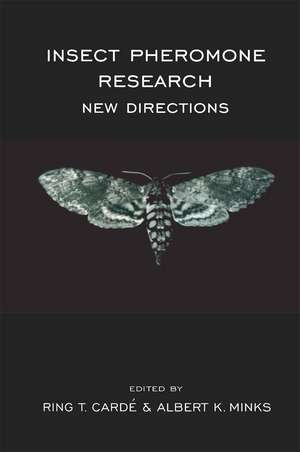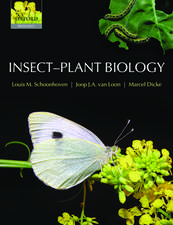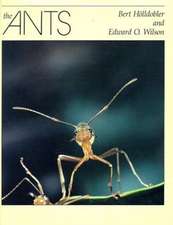Insect Pheromone Research: New Directions
Autor R. T. Carde, A.K. Minksen Limba Engleză Paperback – 17 oct 2012
| Toate formatele și edițiile | Preț | Express |
|---|---|---|
| Paperback (1) | 1833.78 lei 6-8 săpt. | |
| Springer Us – 17 oct 2012 | 1833.78 lei 6-8 săpt. | |
| Hardback (1) | 1843.29 lei 6-8 săpt. | |
| Springer Us – 28 feb 1997 | 1843.29 lei 6-8 săpt. |
Preț: 1833.78 lei
Preț vechi: 2236.32 lei
-18% Nou
Puncte Express: 2751
Preț estimativ în valută:
350.93€ • 381.06$ • 294.79£
350.93€ • 381.06$ • 294.79£
Carte tipărită la comandă
Livrare economică 23 aprilie-07 mai
Preluare comenzi: 021 569.72.76
Specificații
ISBN-13: 9781461379263
ISBN-10: 1461379261
Pagini: 712
Ilustrații: XXIII, 684 p.
Dimensiuni: 152 x 229 x 37 mm
Greutate: 0.93 kg
Ediția:Softcover reprint of the original 1st ed. 1997
Editura: Springer Us
Colecția Springer
Locul publicării:New York, NY, United States
ISBN-10: 1461379261
Pagini: 712
Ilustrații: XXIII, 684 p.
Dimensiuni: 152 x 229 x 37 mm
Greutate: 0.93 kg
Ediția:Softcover reprint of the original 1st ed. 1997
Editura: Springer Us
Colecția Springer
Locul publicării:New York, NY, United States
Public țintă
ResearchCuprins
I. Control of Pheromone Production.- 1. Neural and Endocrine Control of Pheromone Production and Release in Cockroaches.- 2. Control of Pheromone Production in Moths.- 3. Regulation of Pheromone Production in Lepidoptera: The Need for an Ecological Perspective.- 4. Interaction of PBAN with Biosynthetic Enzymes.- 5. PBAN Regulation of Sex Pheromone Biosynthesis in.- 6.The Effect of PBAN on Conversion of Fatty Acyls to Pheromone Aldehydes in Female.- 7. Structure—Function Relationships of PBAN/MRCH.- 8. Multifunctionality of PBAN-Related Neuropeptides: Melanotropic Activity of FXPRLamide Peptides.- 9. Physiological and Cellular Mode of Action of Pheromone Biosynthesis Activating Neuropeptide (PBAN) in the Control of Pheromonotropic Activity of Female Moths.- 10.Mode of Action of Pheromone Biosynthesis Activating Neuropeptide inBombyx mori.- 11.Involvement of the Nervous System with PBAN.- Rapporteur’s Summary.- 12.Pheromonotropism in Insects: Molecules to Molecular Biology.- II. Sensory Processing of Pheromone Signals.- 13.Sensory Processing of Pheromone Signals.- 14. Molecular Mechanisms of Pheromone Perception in Insect Antennae.- 15. Pheromone-Binding Proteins, Pheromone Recognition, and Signal Transduction in Moth Olfaction.- 16. Olfactory Coding Mechanisms for Pheromone and Interspecific Signal Information in Related Species of Moths.- 17. Antennal Lobe Projection Patterns of Pheromone-Specific Olfactory Receptor Neurons in Moths.- 18. Anatomical and Physiological Diversity in the Central Processing of Sex-Pheromone Information in Different Moth Species.- 19. Neuroendocrine Factors in the Photoperiodic Control of Male Moth Responsiveness to Pheromone.- Rapporteur’s Summary.- 20. Neurobialogy of Pheromonal Signal Processing in Insects.- III. Neuroethology ofPheromone-Mediated Responses.- 21.Odor Plumes and the Signal They Provide.- 22. A Tentative Intercausal Nexus and Its Computer Model on Insect Orientation in Windborne Pheromone Plumes.- 23.Pheromone-Mediated Flight in Moths.- 24.Modulation of Pheromone-Mediated Flight in Male Moths.- 25.Mechanisms of Flight of Male Moths to Pheromone.- 26. Pheromone Processing in the Lateral Accessory Lobes of the Moth Brain: Flip-Flopping Signals Related to Zigzagging Upwind Walking.- 27. Active Behavior and Reflexive Responses: Another Perspective on Odor-Modulated Locomotion.- Rapporteur’s Summary.- 28.Neuroethological Study of Pheromone-Modulated Responses.- IV. Use of Pheromones in Direct Control.- 29.Mechanisms of Mating Disruption in Moths.- 30. Measuring Pheromone Concentrations in Cotton Fields with the EAG Method.- 31. Measuring Pheromone Dispersion in the Field with the Single Sensillum Recording Technique.- 32.Mating Disruption of the Codling Moth.- 33.Mating Disruption in European Vineyards.- 34. Successful Area-Wide Program to Control Pink Bollworm by Mating Disruption.- 35.Integrating Pheromones into Vegetable Crop Production.- 36. Mating Disruption of the Lightbrown Apple Moth: Portable Electroantennogram Equipment and Other Aspects.- 37. Disruption of Semiochemical-Mediated Aggregation in Bark Beetles.- 38.First Steps in the Use of Aphid Sex Pheromones.- Rapporteur’s Summary.- 39.Putting Pheromones to Work: Paths Forward for Direct Control.- V. Evolution of Pheromone Communication.- 40. Pheromone and Morphology-Based Phylogenies in New Zealand Tortricid Moths.- 41. A Phylogenetic Analysis of Pheromone Communication in Primitive Moths.- 42. Evolution of Male Lepidopteran Pheromones:A Phylogenetic Perspective.- 43. Evolution of Sex Pheromone Communication inPlant-Feeding Scarab Beetles.- 44. A Genetic Study on Pheromonal Communication in TwoCtenopseustisMoths.- 45.Genetics of Pheromone Communication in the Cabbage Looper MothTrichoplusia ni.- 46. Effects of Interspecific Hybridization betweenHeliothis virescensandHeliothis subflexaon the Sex Pheromone Communication System.- 47. Can Population Genetic Simulations Help to Interpret Pheromone Evolution?.- Rapporteur’s Summary.- 48.Genetic and Phylogenetics in the Evolution of Sex Pheromones.- References.














